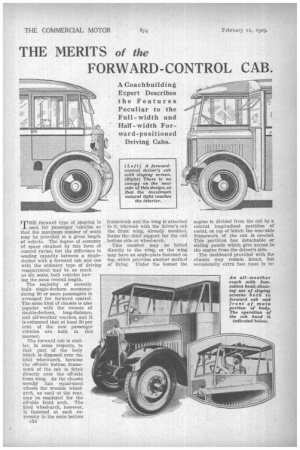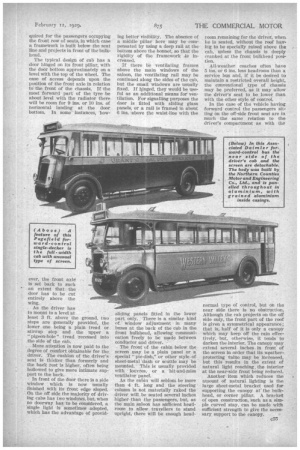THE MERITS of the
Page 18

Page 19

If you've noticed an error in this article please click here to report it so we can fix it.
FORWARD-CONTROL CAB.
THE forward type of steering is .used for Passenger vehicles so that the maximum number of seats may be provided in a given length of vehicle. The degree of economy of space obtained by this form of control varies, but the difference in seating capacity between a singledecker with a forward cab and one with the ordinary type of driving compartment may be as much as .six seats, both vehicles having the same overall length.
The majority of recently built single-deckers accommodating 30 or more passengers is arranged for forward control. The same kind of chassis is also popular with the owners of do able-deckers, long-distance, and all-weather coaches, and it is estimated that at least 50 per cent. of the new passenger vehicles are built in this manner.
. The forward cab is similar, in some respects, to that part of the body 'Which is disposed over the hind wheel-arch, because the off-side bottom framework of the cab is fitted directly over the off-side front wing. As the chassis usually has equal-sized wheels the wooden wheelarch, as used at the rear, may be employed for the off-side front arch, The Lind wheel-arch, however, Is fastened at each extremity to the main bottom c34 framework and the wing is attached to it, whereas with the driver's cab the front wing, already mounted, forms the chief support for the cab bottom side or wheel-arch.
This member May be bolted directly to the wing, or the wingmay have an angle-plate fastened on top, which provides another method of fixing. Under the bonnet the
engine is divided from the cab by a central longitudinal partition of metal, on top of 'which the near-side framework of the cab is erected. This partition has detachable or sliding panels which give access to the engine from the driver's side.
The dashboard provided with the chassis may remain intact, but occasionally extra foot room is re (mired for the passengers occupying the front row of seats, in which case a framework is built below the seat line and projects in front ef the bulkhead.
The typical design of cab has a door hinged on its front pillar, with the door bottom approximately on a level with the top of the wheel. The ease of access depends upon the position of the front axle in relation to the front of the chassis. If the most forward part of the tyre be about level with the radiator there will be room for 9 ins. or 10 ins, of horizontal landing at the door bottom. In some instances, how
ever, the front a.xl is set back to such an extent that. the the door has to be cut entirely above the wing.
As the driver has to mount to a level at ' least 3 ft. above the ground, two steps are generally provided, the lower one being a plain tread or stirrup step and the upper a " pigeon-hole " tread -recessed into the side of the cab.
More attention is now paid to the degree of comfort obtainable for the driver.. The .cushion of the driver's seat is thicker than formerly and the back rest is higher, often being hollowed to give more intimate sup port to the back. •
In front of the door there is a side window, which is now usually finished with its front edge sloped. On the off side the majority of driving cabs has two windews, but, when no doorway has to be considered, a single light is sometimes adopted, which has the advantage of provid ing better visibility. The absence of a middle pillar here may becompensated by using a deep rail at the bottom above the bonnet, so that the rigidity of the framework -is increased.
If there he ventilating frames above the main windows of the saloon, the ventilating rail may be continued along the sides of the cab, but the small windows are usually fixed. If hinged-, they would be useful as an additional means for ventilation. For signalling purposes the door is fitted with sliding glass panels, or a rail is framed in about 6 ins, above the waist-line with the
sliding panels fitted in the lower part only.: There is a similar kind of window adjustment in many buses at the back of the cab in the front bulkhead, allowing communication 'freely to be made between conductor and driver.
The front of the cabin below the screen may be a plain panel or a special." pie-dish," or other style • of sheet-metal 'clash 'or scuttle may be mounted. • This is usually provided with louvres, or a hit-and-miss
ventilator panel. • • • As the cabin will seldom. he more than .4 ft. long and tile steering column is not materially raked the driver will be seated several inches higher than the 'passengers, but, as the main saloon has sufficient headroom to allow travellers to stand upright, there will be enough head
room remaining for the driver, when he is seated, without the roof having to be specially raised above the cab, unless the chassis is deeply cranked at the front bulkhead position.
All-weather coaches often have 5 ins. or 6 ins, less headroom than a service bus and, if it be desired to maintain a restricted overall height, the conventional type of chassis may be preferred,. as it may allow the driver's seat to be lower than with the other style of control.
In the case of the vehicle having forward control the passengers sitting on the off-side front seat are in much the same relation to the drivel's. compartment as with the normal type of control, but on the near side there is no obstruction. Although the cab projects on the off side only, the front part of the roof is given a symmetrical appearance ; that is, half of it is only a canopy which may keep off the rain effectively, but, otherwise, it tends to darken the interior. The canopy may extend several inches in front of the screen in order that its weatherprotecting Value may be increased, but this results in the extent of natural light reaching the interior at' the near-side front being reduced.
Another item which reduces the • amount of natural lighting is the large sheet-metal bracket used for supporting the canopy at' the bulkhead, or corner pillar. A bracket of open construction, such as a simple curved stay, can be made with sufficient strength to give the necessary support to the canopy.






























